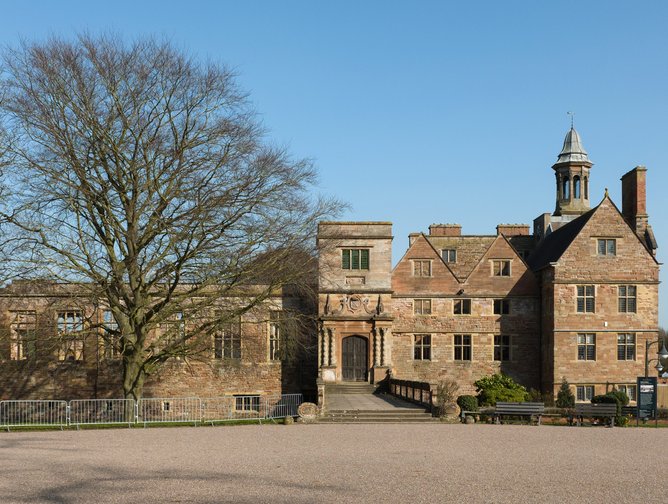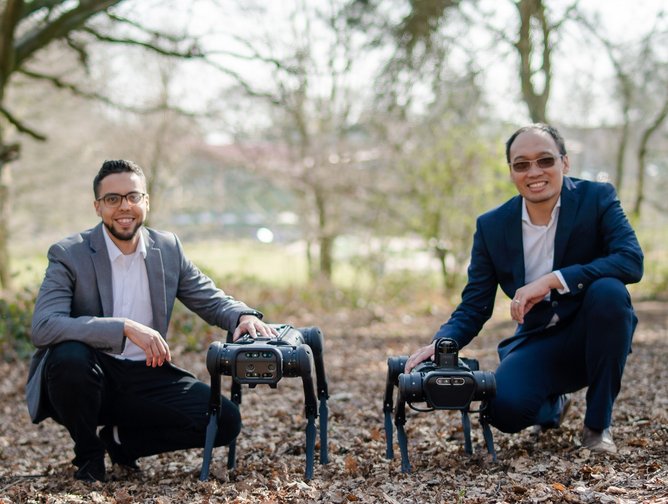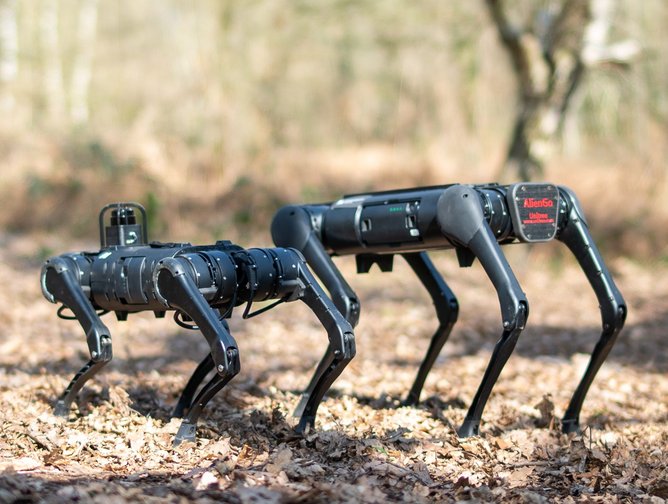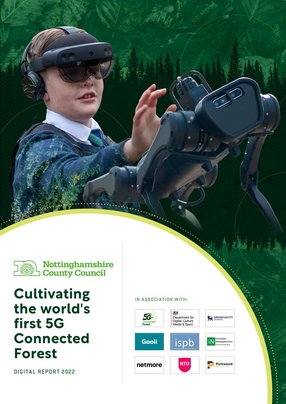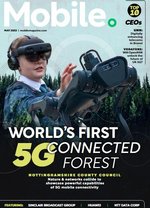Hidden amid a copse showing the early signs of spring ‒ newly-sprouting leaves, green shoots and a morning chorus of birds ‒ is a scene so tranquil and seemingly untouched, you wouldn’t imagine that it could be the site of one of the most innovative, far-reaching digital projects in the UK showcasing the true extent of 5G capabilities.
But there’s one woman who could see the scope of potential being overlooked in natural spaces such as Sherwood Forest and Rufford Abbey Country Park in Nottinghamshire.
“In one of my visits to Sherwood Forest, I realised that it has so much potential but doesn't have any connectivity to do anything ‒ for social media sharing, to connect people, to enhance the visitor experience,” explains Ceren Clulow, Digital Connectivity Manager, Nottinghamshire County Council (NCC), and Ericsson’s ‘5G Trailblazer’.
Imagining a world where nature and technology could be inextricably linked together, Clulow set about turning her ambitious vision into reality. She embarked upon a state-of-the-art digital connectivity project in and around the world famous Sherwood Forest area, located in the north of Nottinghamshire, in early 2020.
Clulow beams with pride as she elaborates on her fascinating journey: “I was looking for some funding opportunities and came across one from the Department for Digital, Culture, Media & Sport [DCMS]. In the briefing event I attended, I said, ‘I have an ambition. After doing some research, I’ve found that there is not a forest in the world that has 5G connectivity. Do you think this is possible? Do you think we can test if 5G works in a forest?’. So, I got the push from DCMS to go for it ‒ ‘Let's try, don't stop’.”
And that’s how the 5G Connected Forest was born ‒ the first of its kind.
Leading Nottinghamshire to a technologically-integrated, sustainable future
Aiming to transform and uplift natural spaces within the locality, the project was based around the concept of a 5G-connected forest at its very core. It would include various strands, such as leisure, rural conservation, careers and skills, and health and social care, to make it a well-rounded project beneficial for future generations.
“The Council has property, planning, commissioning, highways, travel, transport, infrastructure and economic growth and development under the Place Department. We’ve always thought of digital as an enabler in bringing innovations to these different areas,” says Clulow.
Determined to get the project underway, Clulow established links with influential businesses, 5G network providers, tech companies, and academic institutes primarily within the Midlands, to draw out the best of both nature and technology for the purposes of conservation, education, health, and social mobility.
The process of getting the project off the ground was much more difficult than first expected, however, as Clulow explains: “I contacted major national operators, getting fully closed doors in my face and ‘no, we can't do it, it's too difficult’ ‒ some parts of this forest are really protected, so you can't even walk in them. And, of course, with hundreds of thousands of years of forest, people think it’s the last place you can bring in innovation, which is why everybody was saying, ‘no, it's impossible’.
“One of my strengths is that I never give up ‒ so I didn't. I found some partners and we shared an ambition. We thought about the kinds of use cases, identifying visitor experience and environmental management, both of which are really key at the moment. Then I applied for the funding, where I must have convinced DCMS, and secured £10m from them to bring the first 5G signal into a forest setting.”
The initial idea was formulated with Sherwood Forest in mind, a location associated with the legend of Robin Hood. Today, it's a 450-acre natural reserve managed by the RSPB, a third-party shared organisation that NCC works with to preserve and maintain the sustainability of the forest. Within the forest’s expanse, there are hundreds of trees over 500 years old, as well as the rather famous Major Oak that’s estimated to be between 800-1100 years old ‒ all of which is, as you’d expect, heavily protected.
“We were thinking of how we need to protect this forest and show new generations how to do so, while also learning the history,” says Clulow. “So we worked with the RSPB when undertaking trials, asking what we’re allowed to do and where we’re allowed to fly the drones, because we’re not trying to damage nature ‒ we’re trying to work around and with it, while also supporting and protecting it to make it even better.”
Combining and layering the project’s various strands
In addition to identifying Sherwood Forest as a 5G trial testbed for technology including AI and robotics, IoT, drones, and augmented reality (AR) Rufford Abbey Country Park ‒ which is just a handful of miles away from the forest ‒ also became a key focus, albeit one with a heavier lean towards device connectivity for leisure and events (more on that later).
Before drilling down into the specifics of what could be done at each site, though, the first step had to revolve around cultivating a 5G network from which other forms of technology could run. This is where Netmore, delivering and operating highly secure networks to enable connectivity for IoT devices and open up the opportunities of 5G, got involved, along with Mavenir, which provided the necessary equipment for the project.
“Another one of my strengths is partnership and relationship management ‒ meeting with people, networking and also sharing my ambition,” says Clulow matter-of-factly about her uncanny ability to put anyone and everyone around her at ease. “Pitching the target and trying to find a solution, I met with Netmore’s Stefan Stanislawski at a conference in London. During a coffee break, we were just chatting ‒ and I must have been pitching it really well because he was really interested and came up with some solutions. We just started a brainstorming session. And then we became partners.
“As a local authority, you need to know your area really well. You need to know your businesses. You need to know your community really well. What are their needs, what they want, what they don't like, the number of businesses, who are their local communities, schools, academic partners? This is what we do in the Growth, Infrastructure and Development team at the authority. We work really close with our business and communities.”
This then started Clulow off on identifying small- and medium-sized businesses, enterprises and educational institutes in the Nottinghamshire and Midlands’ region that could become solid partners in the 5G project ‒ which is how the likes of Gooii, ISPB, Parkwood Leisure, Birmingham City University (BCU) and Nottingham Trent University (NTU) got involved.
“Gooii and ISPB are local small- and medium-sized enterprises from Nottinghamshire and they became our partners. We knew that we had some really innovative academic institutions in the region, too, in Birmingham City University and Nottingham Trent University ‒ they just understood the role they could play,” Clulow says, creating a picture of the partner ecosystem underpinning the project. “Parkwood Leisure, which manages Rufford Abbey Country Park, was involved from the very start, in early discussions. They're one of our largest businesses, managing the Abbey and grounds for Nottinghamshire County Council.”
Although she successfully managed to pull together a skilled team and identify key elements to focus on, the road ahead wasn’t a smooth one ‒ but for reasons no-one could have anticipated.
“Two weeks after this project launched, we went through a pandemic that impacted the world. Not everyone could stay on the project. All of the partners I mentioned, though, stayed on the project throughout, they delivered it. They continued working on the project plan because they really wanted to see that result,” Clulow says.
Despite the setback and obvious difficulties wrought by the pandemic, the team carried on working together to make their shared vision a reality ‒ and the fruits of their labour are more than evident today.
Sherwood Forest: woodland conservation tracing footsteps of Robin Hood
Each individual project site had its own core objectives and, as such, its own technology, although both were, of course, given the infrastructure to allow for widespread 5G connectivity.
Three tenets were essential to the Sherwood Forest site and therefore dictated the technology that could be tested and utilised there: conservation and preservation; forest management; and educational entertainment based on local history. Overall, though, the idea was to increase the number of people visiting and benefitting from such a wonderful, natural, local space.
“The inspiration actually came from me not originally being from the UK ‒ I’ve known of Sherwood Forest since I was a child, and I knew Robin Hood was from the county, so I brought my children to walk around. I really wanted to make a change, a difference, for the forest so in the future, I can say, ‘Do you know what? This was my project, I helped to do this’,” Clulow explains, outlining a desire to leave a legacy in a place she has not only made her home, but with which she feels a childhood affiliation.
“Also, climate change is really impacting at the moment and our forest is unfortunately declining ‒ it's getting smaller and smaller, and we want to protect it for future generations. With my role now, it’s about how I can use that initiative to promote environmental sustainability; this is where the passion comes from, because I knew the forest before.”
With full 5G connectivity and other pieces of technology developed by BCU, the project trials have demonstrated their effectiveness in monitoring the state of the forest. The robotic dogs are programmed to explore the forest floor using sensors to detect terrain and its overall health, as well as identify the volume of sunlight reaching through the trees. The drones, meanwhile, can fly above the canopy of trees and assess health ‒ from identifying symptoms related to lack of nutrients and poor sunlight to dehydration and disease. With this real-time data, institutes such as the RSPB can act efficiently to preserve and care for the forest.
“It is circular. We want people to come here, to stay here longer, have a different experience than on the walk around. And, maybe in 20 years’ time, they can come with their own children and have the same experience or the same kind of forest rather than something that’s declining.”
The other element of the Sherwood site is the augmented reality visitor experience, provided by Gooii Ltd, which also wrote and produced what is possibly the world’s first interactive holographic movie, featuring the likes of Robin Hood. And where better to take in the legend of Robin Hood than the very place it’s set?
Rufford Abbey Country Park: bringing history to life
At the project’s second site, there was a more human-centred focus on the capabilities 5G connectivity could open up. From eye-opening careers advice and skills practice with ISPB for local students to working with NTU to develop the Rufford Abbey App.
With wider connectivity possibilities due to the new 5G infrastructure, Parkwood Leisure has been able to work with other members of the partner ecosystem to develop and install Abbey Tales at Rufford, offering an interactive journey of discovery to visitors and welcoming them to be immersed in the Abbey’s almost 900-year history. This is on top of the additional capabilities 5G offers for wedding packages, particularly in the post-pandemic world of Zoom.
The unique app created in conjunction with NTU has a more social, emotional and physical wellness slant to it. In the wake of the pandemic, many people’s physical and emotional health suffered enormously, so the app is designed to encourage families and individuals to explore the grounds of Rufford Abbey in a bid to increase the amount of exercise and fresh air people experience.
Each and every element is designed to work seamlessly with and around the others, aiding people in subtle but incredibly useful ways.
Looking ahead: the future of 5G, IoT, AI, AR and robotics
Immersed in the natural beauty of Sherwood Forest and the ruins of Rufford Abbey ‒ nestled within the grounds of Rufford Country Park ‒ the project’s settings act as magical gateways into history, science and the natural world, supported by groundbreaking digital infrastructure and a dedicated team of professionals, a feat many saw as impossible.
With such an unprecedented success on her hands, Clulow is now considering a whole host of options for how she can continue to take this project further, expanding its remit and impacting local communities well into the future.
“We want world-class digital infrastructure to be used for different technologies on a larger scale so that younger generations stay in the county,” she says. “To be successful in this sector, local authorities need to be aware of their assets. The buildings are what we can utilise, and we need to know our not spots and hotspots.
“With that, I mean we need to know where there’s fixed and mobile broadband coverage in each street so that we can identify projects for areas that actually need support ‒ being able to make good decisions comes from being informed.
Clulow reveals that she has already dreamed up new directions that she can take the project in: “We’ve secured funding from the local government association for a Digital Pathfinders project. The idea is to fit a device in our waste recycling vehicles, which travel through each street, to help collect data for us about 4G and 5G coverage. Birmingham City University, our delivery partners, will be putting this information into a map and that will be published on our website.
“That map will not only help us to provide some information about the areas requiring support, but it will also help communities and businesses to access the most accurate information for the area. Unfortunately this kind of information is not shared by Ofcom or mobile network operators with the same accuracy. So we want to help residents if they're buying a house, if they are developing a business, if they're expanding their business ‒ we want to help them and provide the most accurate information for them to use,” she concludes, her mind clearly still buzzing with possible projects to work on.
It’s this imaginative problem solving underpinning the entire project ‒ as well as the unwavering dedication from everyone involved ‒ that really helped the full scope to materialise, in spite of the pandemic and every other obstacle.
Now, as the final tests and trials take place, ready for launch, the team can breathe a sigh of relief and enjoy the realisation of what was thought by many to be impossible: a 5G Connected Forest. And there’s no one more to thank for that than Ceren Clulow; a 5G trailblazer, indeed.
